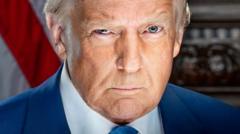In a striking departure from typical presidential portraits, Donald Trump's latest official image, captured by his chief photographer Daniel Torok, has ignited discussions and interpretations surrounding its dramatic style and underlying messages. The photo portrays a serious-looking Trump, characterized by a stern expression and an intense gaze, leading many observers to describe it as having a "message picture" quality.
Former White House photographer Eric Draper shared insights with the BBC, noting the deep impact official portraits have, being the most circulated images of presidents in history. He expressed a belief that Trump's new portrait appears to be "heavily manipulated," utilizing dramatic studio lighting that casts an ominous, almost theatrical quality to the composition. This unconventional lighting choice, illuminating Trump from below, creates a stark contrast often associated with horror films and evokes a sense of seriousness and determination.
The unusual portrayal has drawn comparisons to Trump's infamous mug shot from 2023, which became virally embedded in national culture. Photography YouTuber Jared Polin noted that the mug shot had a significant influence on the new portrait, as it had rapidly become one of the most searched images. This synergy illustrates the complexity of already polarized political imagery, where a singular image can embody vast socio-political sentiments.
Contrasting sharply with Trump's official portrait taken in 2017, the new image signals a strategic image overhaul with implications for political communication. Andrew Parsons, a seasoned political photographer, emphasizes that Trump’s current portrayal is crafted to convey a resolute message rather than portray a personable side. As the narrative shifts from a business-like persona to one marked by political gravitas, critics and supporters alike recognize the potency of image cultivation in American politics.
This photograph's reception underscores a crucial reality: political imagery can wield substantial influence in shaping public perception and potentially impacting electoral outcomes. With images taking center stage in political campaigns, Trump's latest official portrait is not just a photograph; it’s an emblem of intent, a strategic communication that transcends the realm of traditional political imagery. As such, it has become a focal point for discussions regarding the intersection of art, politics, and public sentiment in contemporary America.
Former White House photographer Eric Draper shared insights with the BBC, noting the deep impact official portraits have, being the most circulated images of presidents in history. He expressed a belief that Trump's new portrait appears to be "heavily manipulated," utilizing dramatic studio lighting that casts an ominous, almost theatrical quality to the composition. This unconventional lighting choice, illuminating Trump from below, creates a stark contrast often associated with horror films and evokes a sense of seriousness and determination.
The unusual portrayal has drawn comparisons to Trump's infamous mug shot from 2023, which became virally embedded in national culture. Photography YouTuber Jared Polin noted that the mug shot had a significant influence on the new portrait, as it had rapidly become one of the most searched images. This synergy illustrates the complexity of already polarized political imagery, where a singular image can embody vast socio-political sentiments.
Contrasting sharply with Trump's official portrait taken in 2017, the new image signals a strategic image overhaul with implications for political communication. Andrew Parsons, a seasoned political photographer, emphasizes that Trump’s current portrayal is crafted to convey a resolute message rather than portray a personable side. As the narrative shifts from a business-like persona to one marked by political gravitas, critics and supporters alike recognize the potency of image cultivation in American politics.
This photograph's reception underscores a crucial reality: political imagery can wield substantial influence in shaping public perception and potentially impacting electoral outcomes. With images taking center stage in political campaigns, Trump's latest official portrait is not just a photograph; it’s an emblem of intent, a strategic communication that transcends the realm of traditional political imagery. As such, it has become a focal point for discussions regarding the intersection of art, politics, and public sentiment in contemporary America.
















